Toxic Epidermal Necrolysis, a.k.a. Stevens–Johnson Syndrome

Toxic Epidermal Necrolysis, also known as Stevens–Johnson Syndrome, is a condition where the top layer your skin literally falls off. Caused by an allergic reaction to drugs, it can be fatal.
A number of medications list as a very rare side effect, and one drug in which it is a notable concern is the antiepileptic/mood stabilizer drug lamotrigine. The drug dosage must be raised slowly. When administered thusly, the risk is low, although there have been cases of patients developing allergies to it after years of use.
From the Indian Journal of Dermatology:
Toxic epidermal necrolysis (TEN) is a severe cutaneous adverse reaction to drugs, characterized by extensive detachment of epidermis and mucous membranes with a mortality of 30-40%. An increased occurrence of cutaneous drug reactions is seen in patients with human immunodeficiency virus (HIV) infection. We present this case of TEN caused by ondansetron in an HIV-infected patient. A 24-year-old HIV-1-infected man on antitubercular therapy and cotrimoxazole, presented with extensive and confluent erosions involving the face, trunk, extremities and mucous membranes following the intake of oral ondansetron, ofloxacin and ornidazole. All the drugs were withdrawn and he was treated with intravenous dexamethasone and antibiotics with consequent healing of the erosions. However, the lesions recurred on inadvertent intake of oral ondansetron. He was treated with intravenous antibiotics, fluid resuscitation and supportive care. The skin lesions healed completely over 2 months with postinflammatory depigmentation and scarring, and the eye lesions healed with corneal opacities. We would like to emphasize that the drug most frequently associated with adverse drug reactions may be innocent in a given patient and the physician dealing with a suspected drug reaction must always remain unbiased regarding the causative drug.
